Analysis of Leadership and Management in Nursing: Theories & Styles
VerifiedAdded on 2023/06/10
|9
|2251
|97
Report
AI Summary
This report provides a comprehensive analysis of leadership and management in nursing, addressing the evolving demands of the healthcare environment. It explores the necessity for nurse leaders to develop innovative approaches to meet organizational and managerial needs. The report delves into various leadership theories, including Role Theory, Autocratic, Democratic, and Laissez-faire leadership styles, as well as Benevolent Authoritative, Consultative, and Participative leadership styles. It also examines situational leadership and its adaptability based on staff maturity and competence. Furthermore, the report discusses management theories such as Herzberg's Motivational Theory, Behavioral Science approach, Argyris's theory of humanistic and democratic values, and McClelland's Achievement Motivation Theory. The report emphasizes the importance of creative leadership, highlighting trends like globalization and technological advancements. The conclusion stresses that no single leadership style or theory is universally applicable, and effective nurse leaders must consider the specific context and the individuals they lead when selecting and implementing strategies.
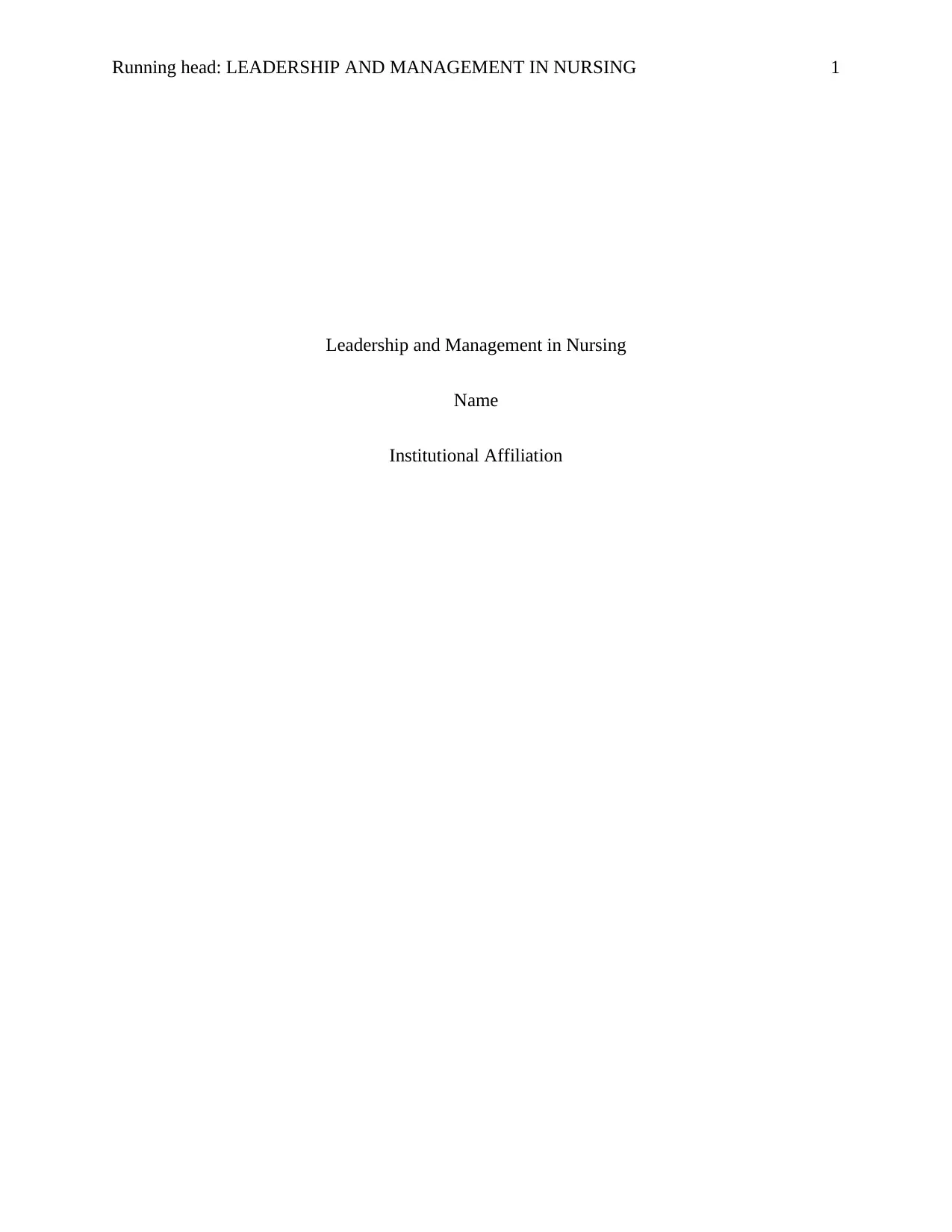
Running head: LEADERSHIP AND MANAGEMENT IN NURSING 1
Leadership and Management in Nursing
Name
Institutional Affiliation
Leadership and Management in Nursing
Name
Institutional Affiliation
Paraphrase This Document
Need a fresh take? Get an instant paraphrase of this document with our AI Paraphraser
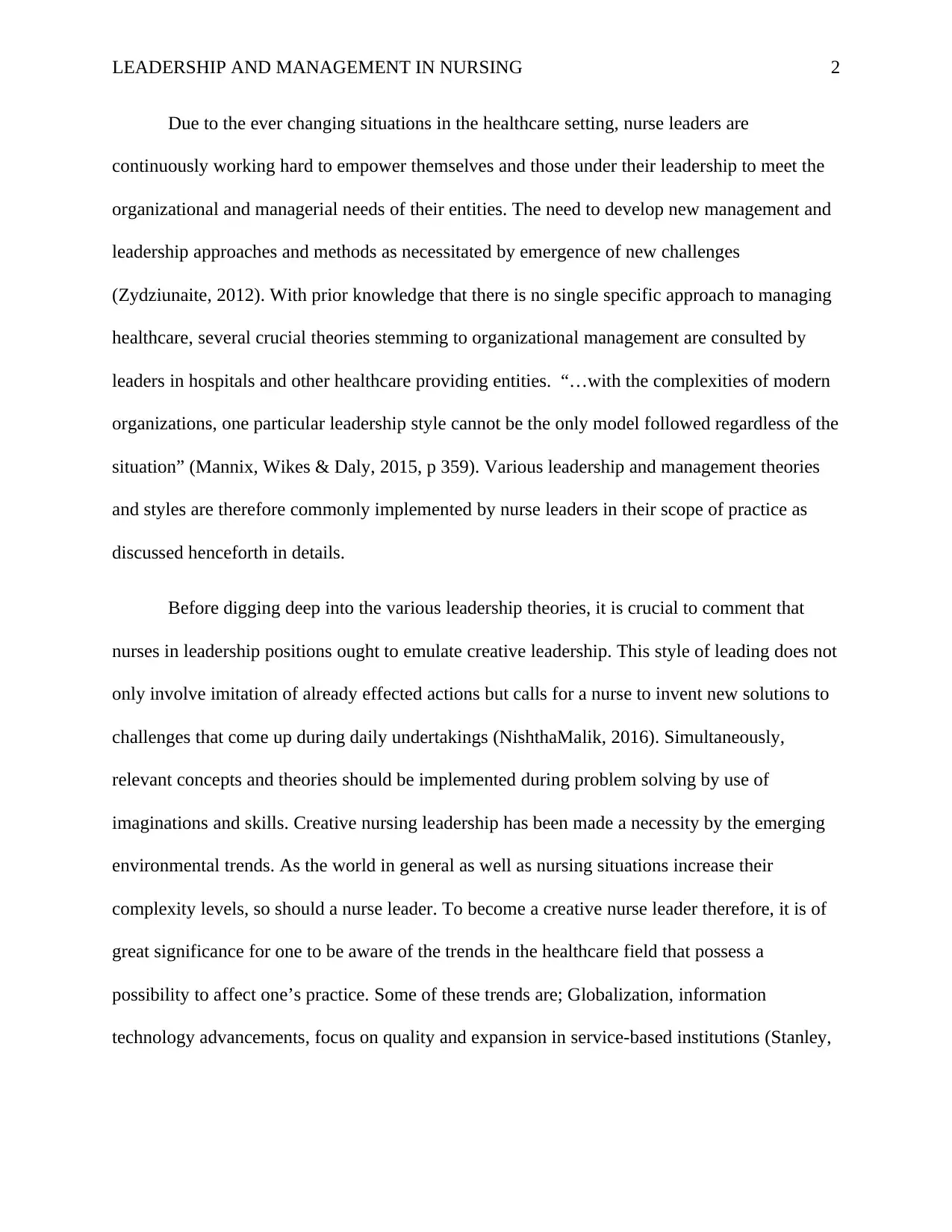
LEADERSHIP AND MANAGEMENT IN NURSING 2
Due to the ever changing situations in the healthcare setting, nurse leaders are
continuously working hard to empower themselves and those under their leadership to meet the
organizational and managerial needs of their entities. The need to develop new management and
leadership approaches and methods as necessitated by emergence of new challenges
(Zydziunaite, 2012). With prior knowledge that there is no single specific approach to managing
healthcare, several crucial theories stemming to organizational management are consulted by
leaders in hospitals and other healthcare providing entities. “…with the complexities of modern
organizations, one particular leadership style cannot be the only model followed regardless of the
situation” (Mannix, Wikes & Daly, 2015, p 359). Various leadership and management theories
and styles are therefore commonly implemented by nurse leaders in their scope of practice as
discussed henceforth in details.
Before digging deep into the various leadership theories, it is crucial to comment that
nurses in leadership positions ought to emulate creative leadership. This style of leading does not
only involve imitation of already effected actions but calls for a nurse to invent new solutions to
challenges that come up during daily undertakings (NishthaMalik, 2016). Simultaneously,
relevant concepts and theories should be implemented during problem solving by use of
imaginations and skills. Creative nursing leadership has been made a necessity by the emerging
environmental trends. As the world in general as well as nursing situations increase their
complexity levels, so should a nurse leader. To become a creative nurse leader therefore, it is of
great significance for one to be aware of the trends in the healthcare field that possess a
possibility to affect one’s practice. Some of these trends are; Globalization, information
technology advancements, focus on quality and expansion in service-based institutions (Stanley,
Due to the ever changing situations in the healthcare setting, nurse leaders are
continuously working hard to empower themselves and those under their leadership to meet the
organizational and managerial needs of their entities. The need to develop new management and
leadership approaches and methods as necessitated by emergence of new challenges
(Zydziunaite, 2012). With prior knowledge that there is no single specific approach to managing
healthcare, several crucial theories stemming to organizational management are consulted by
leaders in hospitals and other healthcare providing entities. “…with the complexities of modern
organizations, one particular leadership style cannot be the only model followed regardless of the
situation” (Mannix, Wikes & Daly, 2015, p 359). Various leadership and management theories
and styles are therefore commonly implemented by nurse leaders in their scope of practice as
discussed henceforth in details.
Before digging deep into the various leadership theories, it is crucial to comment that
nurses in leadership positions ought to emulate creative leadership. This style of leading does not
only involve imitation of already effected actions but calls for a nurse to invent new solutions to
challenges that come up during daily undertakings (NishthaMalik, 2016). Simultaneously,
relevant concepts and theories should be implemented during problem solving by use of
imaginations and skills. Creative nursing leadership has been made a necessity by the emerging
environmental trends. As the world in general as well as nursing situations increase their
complexity levels, so should a nurse leader. To become a creative nurse leader therefore, it is of
great significance for one to be aware of the trends in the healthcare field that possess a
possibility to affect one’s practice. Some of these trends are; Globalization, information
technology advancements, focus on quality and expansion in service-based institutions (Stanley,
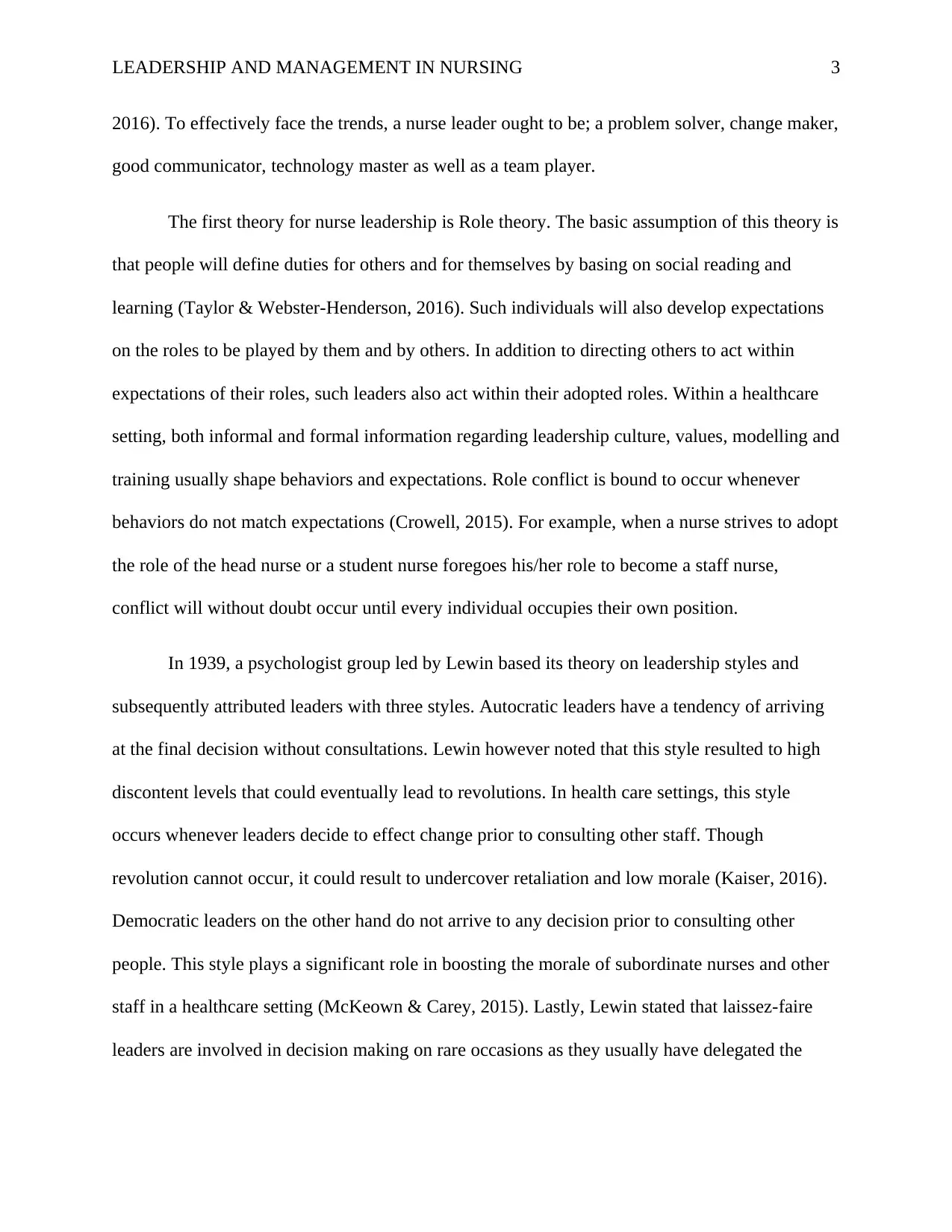
LEADERSHIP AND MANAGEMENT IN NURSING 3
2016). To effectively face the trends, a nurse leader ought to be; a problem solver, change maker,
good communicator, technology master as well as a team player.
The first theory for nurse leadership is Role theory. The basic assumption of this theory is
that people will define duties for others and for themselves by basing on social reading and
learning (Taylor & Webster-Henderson, 2016). Such individuals will also develop expectations
on the roles to be played by them and by others. In addition to directing others to act within
expectations of their roles, such leaders also act within their adopted roles. Within a healthcare
setting, both informal and formal information regarding leadership culture, values, modelling and
training usually shape behaviors and expectations. Role conflict is bound to occur whenever
behaviors do not match expectations (Crowell, 2015). For example, when a nurse strives to adopt
the role of the head nurse or a student nurse foregoes his/her role to become a staff nurse,
conflict will without doubt occur until every individual occupies their own position.
In 1939, a psychologist group led by Lewin based its theory on leadership styles and
subsequently attributed leaders with three styles. Autocratic leaders have a tendency of arriving
at the final decision without consultations. Lewin however noted that this style resulted to high
discontent levels that could eventually lead to revolutions. In health care settings, this style
occurs whenever leaders decide to effect change prior to consulting other staff. Though
revolution cannot occur, it could result to undercover retaliation and low morale (Kaiser, 2016).
Democratic leaders on the other hand do not arrive to any decision prior to consulting other
people. This style plays a significant role in boosting the morale of subordinate nurses and other
staff in a healthcare setting (McKeown & Carey, 2015). Lastly, Lewin stated that laissez-faire
leaders are involved in decision making on rare occasions as they usually have delegated the
2016). To effectively face the trends, a nurse leader ought to be; a problem solver, change maker,
good communicator, technology master as well as a team player.
The first theory for nurse leadership is Role theory. The basic assumption of this theory is
that people will define duties for others and for themselves by basing on social reading and
learning (Taylor & Webster-Henderson, 2016). Such individuals will also develop expectations
on the roles to be played by them and by others. In addition to directing others to act within
expectations of their roles, such leaders also act within their adopted roles. Within a healthcare
setting, both informal and formal information regarding leadership culture, values, modelling and
training usually shape behaviors and expectations. Role conflict is bound to occur whenever
behaviors do not match expectations (Crowell, 2015). For example, when a nurse strives to adopt
the role of the head nurse or a student nurse foregoes his/her role to become a staff nurse,
conflict will without doubt occur until every individual occupies their own position.
In 1939, a psychologist group led by Lewin based its theory on leadership styles and
subsequently attributed leaders with three styles. Autocratic leaders have a tendency of arriving
at the final decision without consultations. Lewin however noted that this style resulted to high
discontent levels that could eventually lead to revolutions. In health care settings, this style
occurs whenever leaders decide to effect change prior to consulting other staff. Though
revolution cannot occur, it could result to undercover retaliation and low morale (Kaiser, 2016).
Democratic leaders on the other hand do not arrive to any decision prior to consulting other
people. This style plays a significant role in boosting the morale of subordinate nurses and other
staff in a healthcare setting (McKeown & Carey, 2015). Lastly, Lewin stated that laissez-faire
leaders are involved in decision making on rare occasions as they usually have delegated the
⊘ This is a preview!⊘
Do you want full access?
Subscribe today to unlock all pages.

Trusted by 1+ million students worldwide
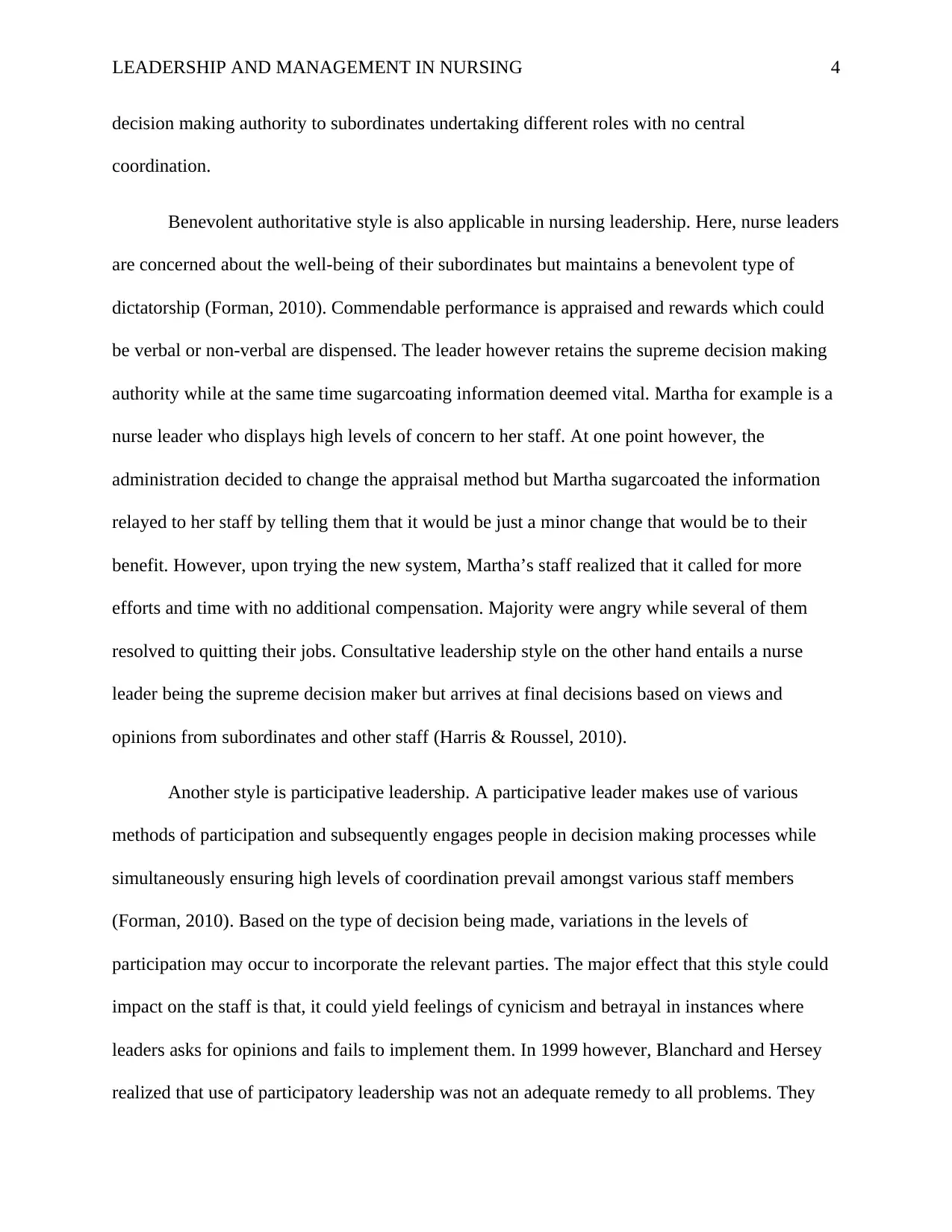
LEADERSHIP AND MANAGEMENT IN NURSING 4
decision making authority to subordinates undertaking different roles with no central
coordination.
Benevolent authoritative style is also applicable in nursing leadership. Here, nurse leaders
are concerned about the well-being of their subordinates but maintains a benevolent type of
dictatorship (Forman, 2010). Commendable performance is appraised and rewards which could
be verbal or non-verbal are dispensed. The leader however retains the supreme decision making
authority while at the same time sugarcoating information deemed vital. Martha for example is a
nurse leader who displays high levels of concern to her staff. At one point however, the
administration decided to change the appraisal method but Martha sugarcoated the information
relayed to her staff by telling them that it would be just a minor change that would be to their
benefit. However, upon trying the new system, Martha’s staff realized that it called for more
efforts and time with no additional compensation. Majority were angry while several of them
resolved to quitting their jobs. Consultative leadership style on the other hand entails a nurse
leader being the supreme decision maker but arrives at final decisions based on views and
opinions from subordinates and other staff (Harris & Roussel, 2010).
Another style is participative leadership. A participative leader makes use of various
methods of participation and subsequently engages people in decision making processes while
simultaneously ensuring high levels of coordination prevail amongst various staff members
(Forman, 2010). Based on the type of decision being made, variations in the levels of
participation may occur to incorporate the relevant parties. The major effect that this style could
impact on the staff is that, it could yield feelings of cynicism and betrayal in instances where
leaders asks for opinions and fails to implement them. In 1999 however, Blanchard and Hersey
realized that use of participatory leadership was not an adequate remedy to all problems. They
decision making authority to subordinates undertaking different roles with no central
coordination.
Benevolent authoritative style is also applicable in nursing leadership. Here, nurse leaders
are concerned about the well-being of their subordinates but maintains a benevolent type of
dictatorship (Forman, 2010). Commendable performance is appraised and rewards which could
be verbal or non-verbal are dispensed. The leader however retains the supreme decision making
authority while at the same time sugarcoating information deemed vital. Martha for example is a
nurse leader who displays high levels of concern to her staff. At one point however, the
administration decided to change the appraisal method but Martha sugarcoated the information
relayed to her staff by telling them that it would be just a minor change that would be to their
benefit. However, upon trying the new system, Martha’s staff realized that it called for more
efforts and time with no additional compensation. Majority were angry while several of them
resolved to quitting their jobs. Consultative leadership style on the other hand entails a nurse
leader being the supreme decision maker but arrives at final decisions based on views and
opinions from subordinates and other staff (Harris & Roussel, 2010).
Another style is participative leadership. A participative leader makes use of various
methods of participation and subsequently engages people in decision making processes while
simultaneously ensuring high levels of coordination prevail amongst various staff members
(Forman, 2010). Based on the type of decision being made, variations in the levels of
participation may occur to incorporate the relevant parties. The major effect that this style could
impact on the staff is that, it could yield feelings of cynicism and betrayal in instances where
leaders asks for opinions and fails to implement them. In 1999 however, Blanchard and Hersey
realized that use of participatory leadership was not an adequate remedy to all problems. They
Paraphrase This Document
Need a fresh take? Get an instant paraphrase of this document with our AI Paraphraser
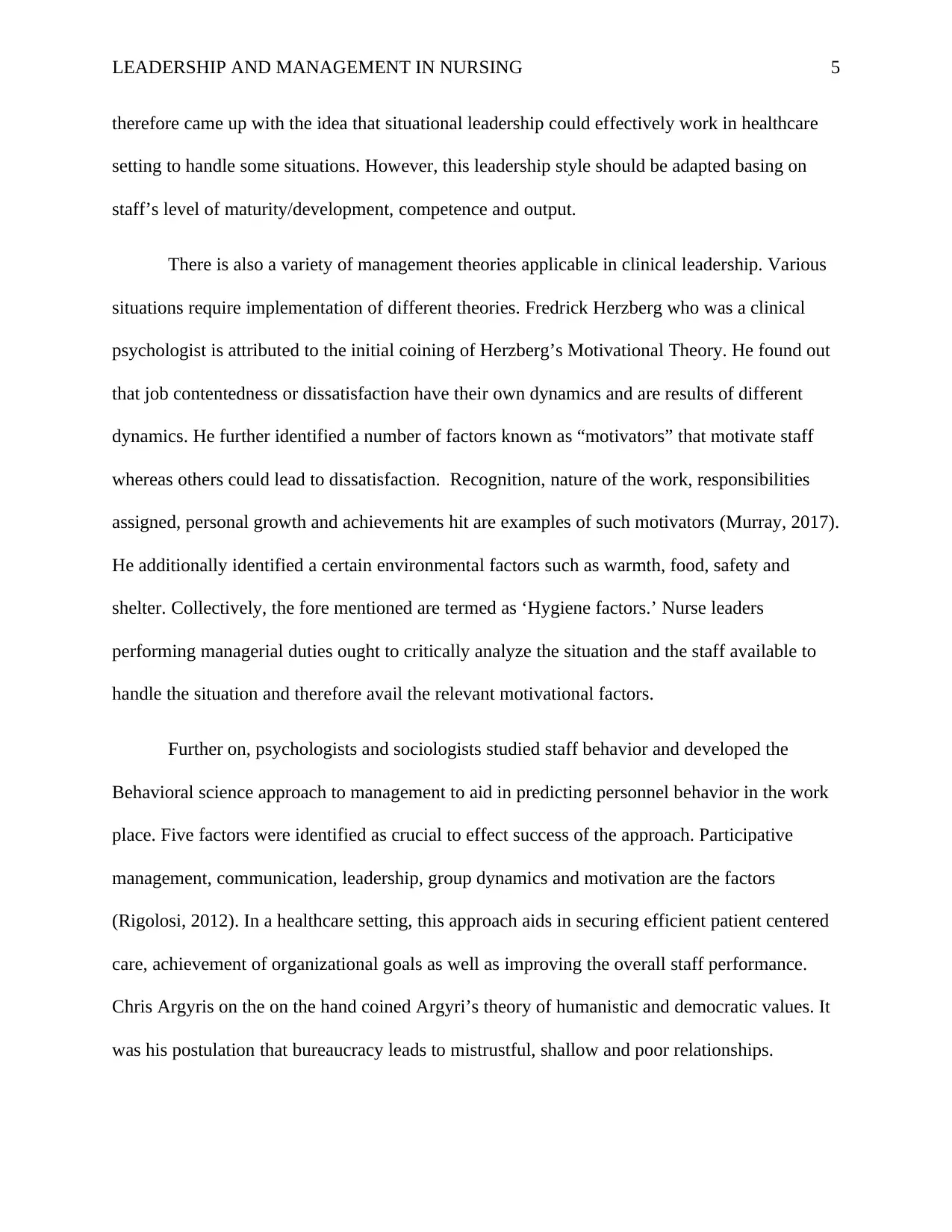
LEADERSHIP AND MANAGEMENT IN NURSING 5
therefore came up with the idea that situational leadership could effectively work in healthcare
setting to handle some situations. However, this leadership style should be adapted basing on
staff’s level of maturity/development, competence and output.
There is also a variety of management theories applicable in clinical leadership. Various
situations require implementation of different theories. Fredrick Herzberg who was a clinical
psychologist is attributed to the initial coining of Herzberg’s Motivational Theory. He found out
that job contentedness or dissatisfaction have their own dynamics and are results of different
dynamics. He further identified a number of factors known as “motivators” that motivate staff
whereas others could lead to dissatisfaction. Recognition, nature of the work, responsibilities
assigned, personal growth and achievements hit are examples of such motivators (Murray, 2017).
He additionally identified a certain environmental factors such as warmth, food, safety and
shelter. Collectively, the fore mentioned are termed as ‘Hygiene factors.’ Nurse leaders
performing managerial duties ought to critically analyze the situation and the staff available to
handle the situation and therefore avail the relevant motivational factors.
Further on, psychologists and sociologists studied staff behavior and developed the
Behavioral science approach to management to aid in predicting personnel behavior in the work
place. Five factors were identified as crucial to effect success of the approach. Participative
management, communication, leadership, group dynamics and motivation are the factors
(Rigolosi, 2012). In a healthcare setting, this approach aids in securing efficient patient centered
care, achievement of organizational goals as well as improving the overall staff performance.
Chris Argyris on the on the hand coined Argyri’s theory of humanistic and democratic values. It
was his postulation that bureaucracy leads to mistrustful, shallow and poor relationships.
therefore came up with the idea that situational leadership could effectively work in healthcare
setting to handle some situations. However, this leadership style should be adapted basing on
staff’s level of maturity/development, competence and output.
There is also a variety of management theories applicable in clinical leadership. Various
situations require implementation of different theories. Fredrick Herzberg who was a clinical
psychologist is attributed to the initial coining of Herzberg’s Motivational Theory. He found out
that job contentedness or dissatisfaction have their own dynamics and are results of different
dynamics. He further identified a number of factors known as “motivators” that motivate staff
whereas others could lead to dissatisfaction. Recognition, nature of the work, responsibilities
assigned, personal growth and achievements hit are examples of such motivators (Murray, 2017).
He additionally identified a certain environmental factors such as warmth, food, safety and
shelter. Collectively, the fore mentioned are termed as ‘Hygiene factors.’ Nurse leaders
performing managerial duties ought to critically analyze the situation and the staff available to
handle the situation and therefore avail the relevant motivational factors.
Further on, psychologists and sociologists studied staff behavior and developed the
Behavioral science approach to management to aid in predicting personnel behavior in the work
place. Five factors were identified as crucial to effect success of the approach. Participative
management, communication, leadership, group dynamics and motivation are the factors
(Rigolosi, 2012). In a healthcare setting, this approach aids in securing efficient patient centered
care, achievement of organizational goals as well as improving the overall staff performance.
Chris Argyris on the on the hand coined Argyri’s theory of humanistic and democratic values. It
was his postulation that bureaucracy leads to mistrustful, shallow and poor relationships.
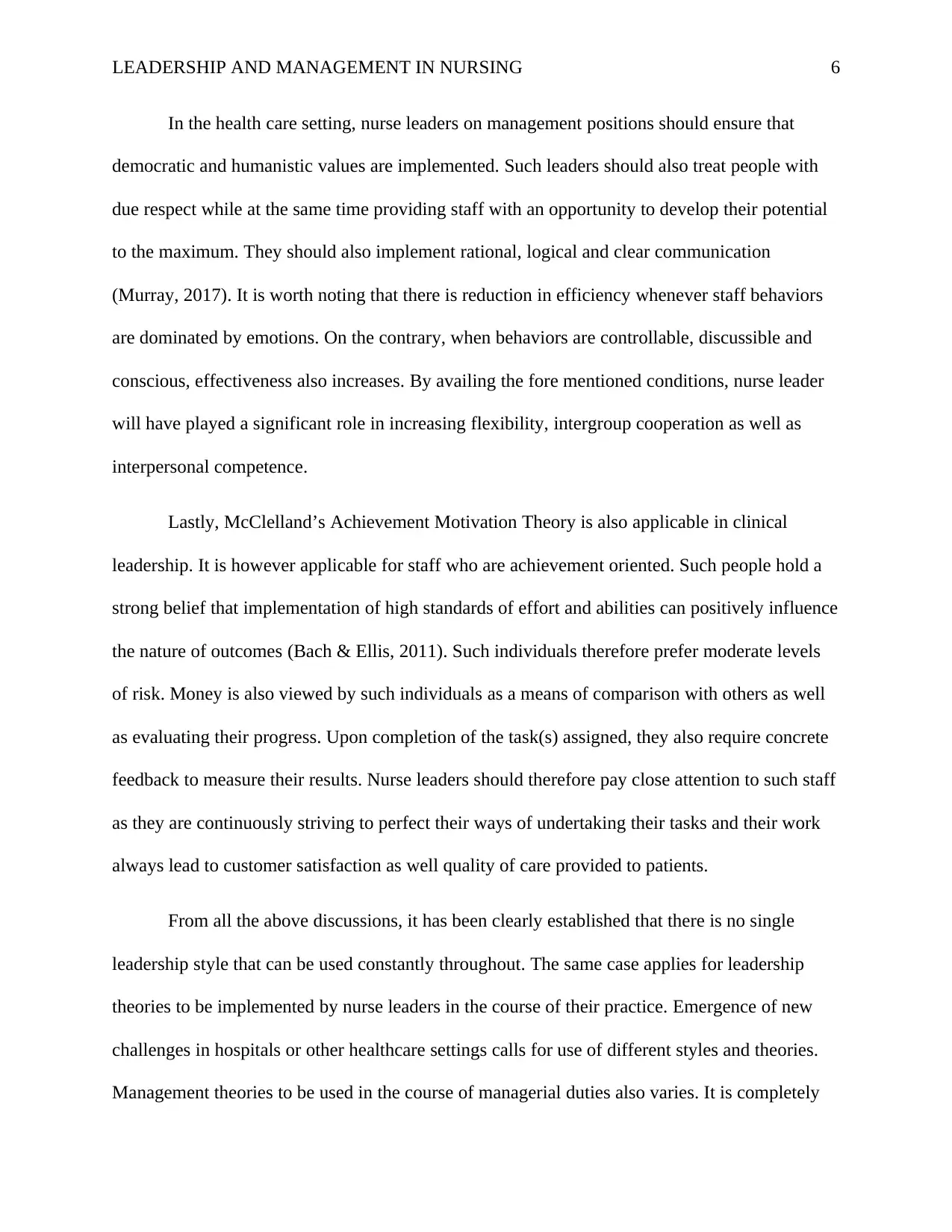
LEADERSHIP AND MANAGEMENT IN NURSING 6
In the health care setting, nurse leaders on management positions should ensure that
democratic and humanistic values are implemented. Such leaders should also treat people with
due respect while at the same time providing staff with an opportunity to develop their potential
to the maximum. They should also implement rational, logical and clear communication
(Murray, 2017). It is worth noting that there is reduction in efficiency whenever staff behaviors
are dominated by emotions. On the contrary, when behaviors are controllable, discussible and
conscious, effectiveness also increases. By availing the fore mentioned conditions, nurse leader
will have played a significant role in increasing flexibility, intergroup cooperation as well as
interpersonal competence.
Lastly, McClelland’s Achievement Motivation Theory is also applicable in clinical
leadership. It is however applicable for staff who are achievement oriented. Such people hold a
strong belief that implementation of high standards of effort and abilities can positively influence
the nature of outcomes (Bach & Ellis, 2011). Such individuals therefore prefer moderate levels
of risk. Money is also viewed by such individuals as a means of comparison with others as well
as evaluating their progress. Upon completion of the task(s) assigned, they also require concrete
feedback to measure their results. Nurse leaders should therefore pay close attention to such staff
as they are continuously striving to perfect their ways of undertaking their tasks and their work
always lead to customer satisfaction as well quality of care provided to patients.
From all the above discussions, it has been clearly established that there is no single
leadership style that can be used constantly throughout. The same case applies for leadership
theories to be implemented by nurse leaders in the course of their practice. Emergence of new
challenges in hospitals or other healthcare settings calls for use of different styles and theories.
Management theories to be used in the course of managerial duties also varies. It is completely
In the health care setting, nurse leaders on management positions should ensure that
democratic and humanistic values are implemented. Such leaders should also treat people with
due respect while at the same time providing staff with an opportunity to develop their potential
to the maximum. They should also implement rational, logical and clear communication
(Murray, 2017). It is worth noting that there is reduction in efficiency whenever staff behaviors
are dominated by emotions. On the contrary, when behaviors are controllable, discussible and
conscious, effectiveness also increases. By availing the fore mentioned conditions, nurse leader
will have played a significant role in increasing flexibility, intergroup cooperation as well as
interpersonal competence.
Lastly, McClelland’s Achievement Motivation Theory is also applicable in clinical
leadership. It is however applicable for staff who are achievement oriented. Such people hold a
strong belief that implementation of high standards of effort and abilities can positively influence
the nature of outcomes (Bach & Ellis, 2011). Such individuals therefore prefer moderate levels
of risk. Money is also viewed by such individuals as a means of comparison with others as well
as evaluating their progress. Upon completion of the task(s) assigned, they also require concrete
feedback to measure their results. Nurse leaders should therefore pay close attention to such staff
as they are continuously striving to perfect their ways of undertaking their tasks and their work
always lead to customer satisfaction as well quality of care provided to patients.
From all the above discussions, it has been clearly established that there is no single
leadership style that can be used constantly throughout. The same case applies for leadership
theories to be implemented by nurse leaders in the course of their practice. Emergence of new
challenges in hospitals or other healthcare settings calls for use of different styles and theories.
Management theories to be used in the course of managerial duties also varies. It is completely
⊘ This is a preview!⊘
Do you want full access?
Subscribe today to unlock all pages.

Trusted by 1+ million students worldwide
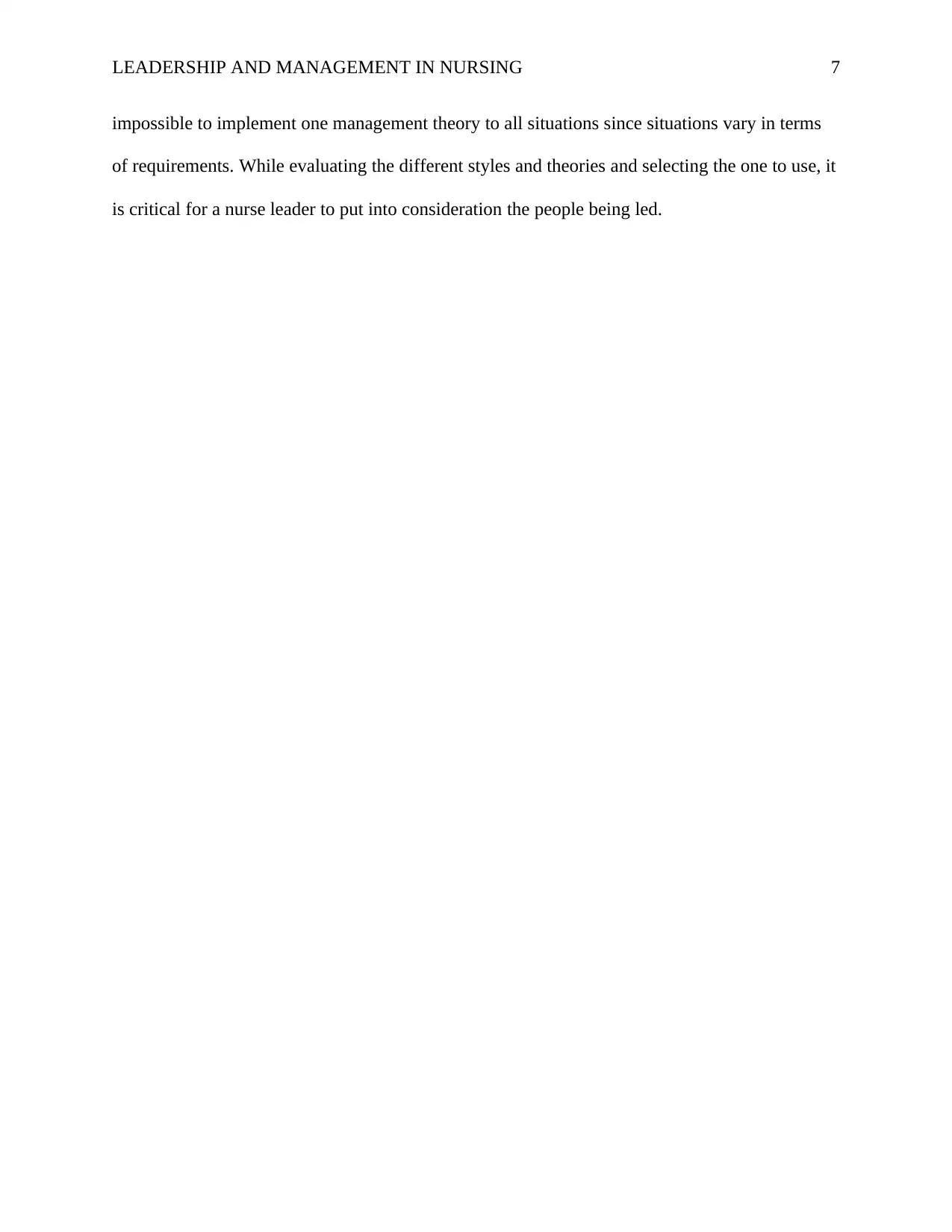
LEADERSHIP AND MANAGEMENT IN NURSING 7
impossible to implement one management theory to all situations since situations vary in terms
of requirements. While evaluating the different styles and theories and selecting the one to use, it
is critical for a nurse leader to put into consideration the people being led.
impossible to implement one management theory to all situations since situations vary in terms
of requirements. While evaluating the different styles and theories and selecting the one to use, it
is critical for a nurse leader to put into consideration the people being led.
Paraphrase This Document
Need a fresh take? Get an instant paraphrase of this document with our AI Paraphraser
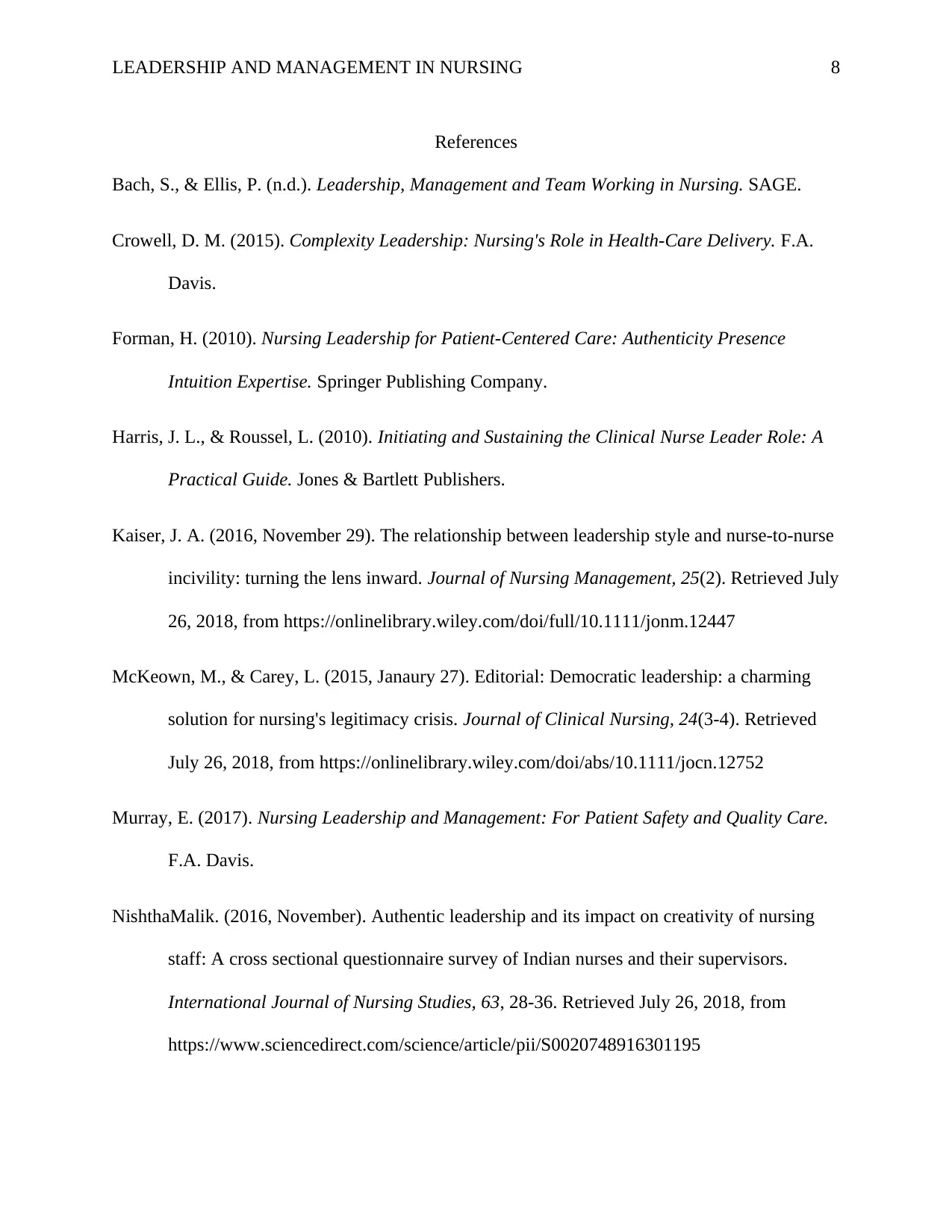
LEADERSHIP AND MANAGEMENT IN NURSING 8
References
Bach, S., & Ellis, P. (n.d.). Leadership, Management and Team Working in Nursing. SAGE.
Crowell, D. M. (2015). Complexity Leadership: Nursing's Role in Health-Care Delivery. F.A.
Davis.
Forman, H. (2010). Nursing Leadership for Patient-Centered Care: Authenticity Presence
Intuition Expertise. Springer Publishing Company.
Harris, J. L., & Roussel, L. (2010). Initiating and Sustaining the Clinical Nurse Leader Role: A
Practical Guide. Jones & Bartlett Publishers.
Kaiser, J. A. (2016, November 29). The relationship between leadership style and nurse‐to‐nurse
incivility: turning the lens inward. Journal of Nursing Management, 25(2). Retrieved July
26, 2018, from https://onlinelibrary.wiley.com/doi/full/10.1111/jonm.12447
McKeown, M., & Carey, L. (2015, Janaury 27). Editorial: Democratic leadership: a charming
solution for nursing's legitimacy crisis. Journal of Clinical Nursing, 24(3-4). Retrieved
July 26, 2018, from https://onlinelibrary.wiley.com/doi/abs/10.1111/jocn.12752
Murray, E. (2017). Nursing Leadership and Management: For Patient Safety and Quality Care.
F.A. Davis.
NishthaMalik. (2016, November). Authentic leadership and its impact on creativity of nursing
staff: A cross sectional questionnaire survey of Indian nurses and their supervisors.
International Journal of Nursing Studies, 63, 28-36. Retrieved July 26, 2018, from
https://www.sciencedirect.com/science/article/pii/S0020748916301195
References
Bach, S., & Ellis, P. (n.d.). Leadership, Management and Team Working in Nursing. SAGE.
Crowell, D. M. (2015). Complexity Leadership: Nursing's Role in Health-Care Delivery. F.A.
Davis.
Forman, H. (2010). Nursing Leadership for Patient-Centered Care: Authenticity Presence
Intuition Expertise. Springer Publishing Company.
Harris, J. L., & Roussel, L. (2010). Initiating and Sustaining the Clinical Nurse Leader Role: A
Practical Guide. Jones & Bartlett Publishers.
Kaiser, J. A. (2016, November 29). The relationship between leadership style and nurse‐to‐nurse
incivility: turning the lens inward. Journal of Nursing Management, 25(2). Retrieved July
26, 2018, from https://onlinelibrary.wiley.com/doi/full/10.1111/jonm.12447
McKeown, M., & Carey, L. (2015, Janaury 27). Editorial: Democratic leadership: a charming
solution for nursing's legitimacy crisis. Journal of Clinical Nursing, 24(3-4). Retrieved
July 26, 2018, from https://onlinelibrary.wiley.com/doi/abs/10.1111/jocn.12752
Murray, E. (2017). Nursing Leadership and Management: For Patient Safety and Quality Care.
F.A. Davis.
NishthaMalik. (2016, November). Authentic leadership and its impact on creativity of nursing
staff: A cross sectional questionnaire survey of Indian nurses and their supervisors.
International Journal of Nursing Studies, 63, 28-36. Retrieved July 26, 2018, from
https://www.sciencedirect.com/science/article/pii/S0020748916301195
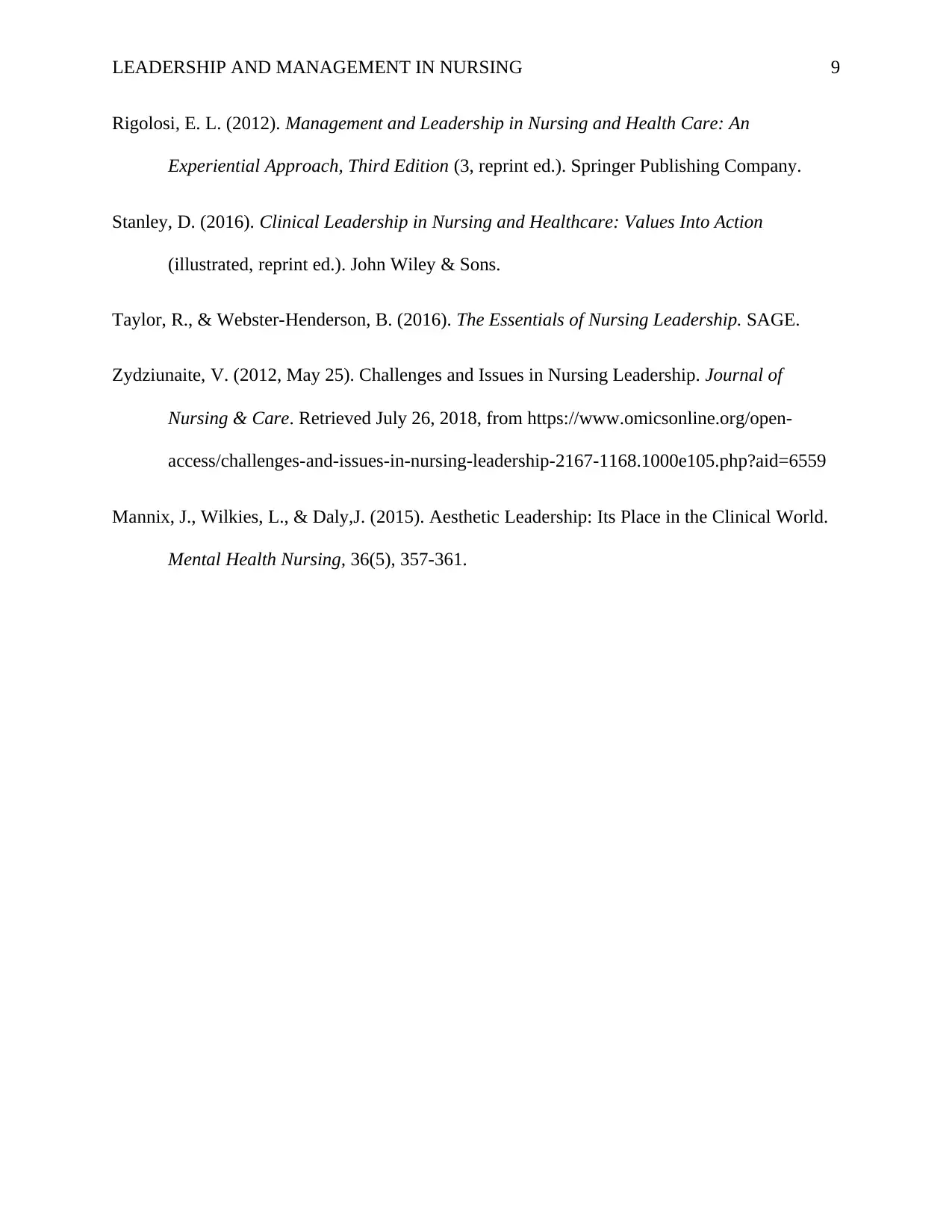
LEADERSHIP AND MANAGEMENT IN NURSING 9
Rigolosi, E. L. (2012). Management and Leadership in Nursing and Health Care: An
Experiential Approach, Third Edition (3, reprint ed.). Springer Publishing Company.
Stanley, D. (2016). Clinical Leadership in Nursing and Healthcare: Values Into Action
(illustrated, reprint ed.). John Wiley & Sons.
Taylor, R., & Webster-Henderson, B. (2016). The Essentials of Nursing Leadership. SAGE.
Zydziunaite, V. (2012, May 25). Challenges and Issues in Nursing Leadership. Journal of
Nursing & Care. Retrieved July 26, 2018, from https://www.omicsonline.org/open-
access/challenges-and-issues-in-nursing-leadership-2167-1168.1000e105.php?aid=6559
Mannix, J., Wilkies, L., & Daly,J. (2015). Aesthetic Leadership: Its Place in the Clinical World.
Mental Health Nursing, 36(5), 357-361.
Rigolosi, E. L. (2012). Management and Leadership in Nursing and Health Care: An
Experiential Approach, Third Edition (3, reprint ed.). Springer Publishing Company.
Stanley, D. (2016). Clinical Leadership in Nursing and Healthcare: Values Into Action
(illustrated, reprint ed.). John Wiley & Sons.
Taylor, R., & Webster-Henderson, B. (2016). The Essentials of Nursing Leadership. SAGE.
Zydziunaite, V. (2012, May 25). Challenges and Issues in Nursing Leadership. Journal of
Nursing & Care. Retrieved July 26, 2018, from https://www.omicsonline.org/open-
access/challenges-and-issues-in-nursing-leadership-2167-1168.1000e105.php?aid=6559
Mannix, J., Wilkies, L., & Daly,J. (2015). Aesthetic Leadership: Its Place in the Clinical World.
Mental Health Nursing, 36(5), 357-361.
⊘ This is a preview!⊘
Do you want full access?
Subscribe today to unlock all pages.

Trusted by 1+ million students worldwide
1 out of 9
Related Documents
Your All-in-One AI-Powered Toolkit for Academic Success.
+13062052269
info@desklib.com
Available 24*7 on WhatsApp / Email
![[object Object]](/_next/static/media/star-bottom.7253800d.svg)
Unlock your academic potential
Copyright © 2020–2025 A2Z Services. All Rights Reserved. Developed and managed by ZUCOL.





